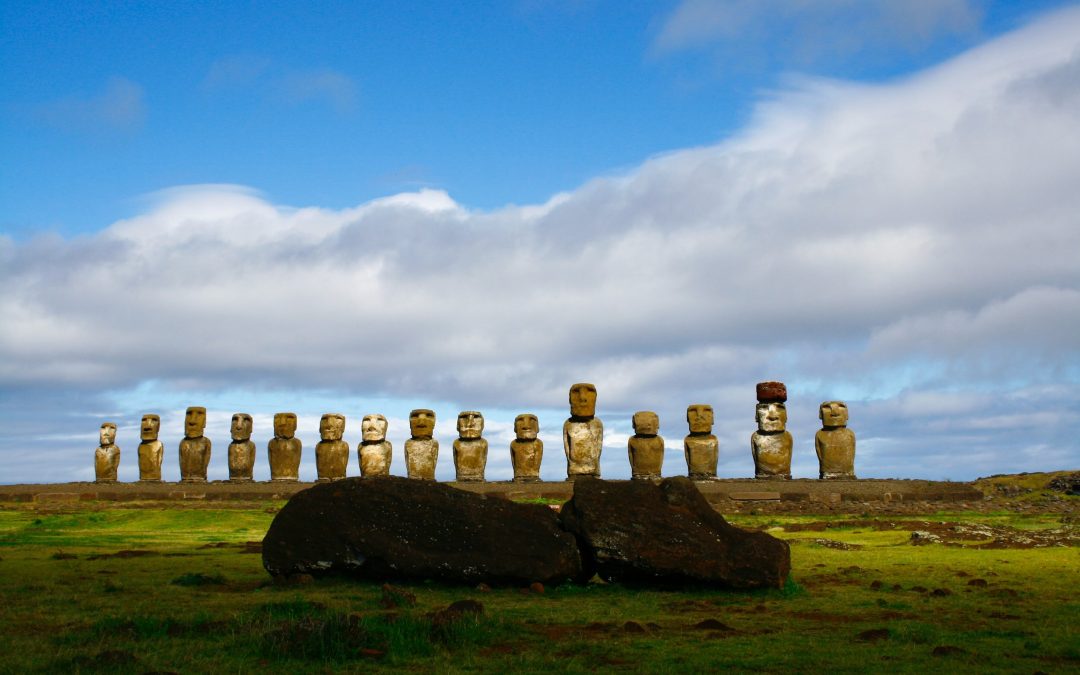
Slaying the Nephilim
This is a part 2 of 2 in my miniseries on giants.
In the last post, I focused on the immediate or historical sense of Genesis 6:4. In this post, I will look at the redemptive nature of the giant theme, which only just begins in Genesis 6:4, and then make application to our present day situation as Christians. Before I begin, let me first answer the charge of an “allegorical” or “spiritual interpretation” of the text, which is bound to be leveled at this post by some—
There is a difference between an unbridled and undisciplined or subjective allegorical interpretation of the text, where any conclusion goes on the one hand; and a historical text which lends itself to a deeper meaning or fuller sense on the other. Typology is like the latter. A type is often a historical person which looks past itself to something other and greater, the antitype. It is, in that sense, a historical substance being used by God as an allegory to teach something other and greater than itself. The New Testament authors assumed this manifold sense of Scripture when engaging Old Testament texts such as Psalm 110, 2 Samuel 7:14, and Hosea 11:1—Hebrews 1 making heavy use of the former two, and Matthew 2:15 making use of the latter. The scope of this article will not allow me to delve into a full-orbed defense of things like the historical-grammatical hermeneutic or the sensus plenior (fuller sense) of the text. These things will largely be assumed henceforth.
The assumption which will drive the following work is as follows: Every text of the Old Testament is applicable to the New Testament believer. I take this to be the meaning of Paul’s maxim set forth as such, “For whatever things were written before were written for our learning, that we through the patience and comfort of the Scriptures might have hope (Rom. 15:4).”
Suffice it to say, I’m not doing anything different than what the apostles did in their interpretive work. Nor am I deviating from the hermeneutic utilized by our Baptist forerunners. I only hope to be consistent with their method.
Recapitulation of Previous Article
So that no one is lost, and so my last article is rightly understood—in it, I took the position that the giants were a people group. The sons of God were men, perhaps from Cain’s seed. The daughters of men were probably descended from Seth’s righteous line. Some understand the sons of God who mated with the human women to be angelic beings. I argued against this on the basis of Genesis 1. Each living thing begets its kind according to the creation narrative. It, therefore, would be non-sensical to suggest angels could produce human offspring, which no doubt occurred, i.e. the men of renown. The sons of God “married” the daughters of men and produced the men of renown who took on the wicked properties of the giants who were then living.
Some other reasons the sons of God and the Nephilim must be human—angels, per Matthew 22 do not marry. Dr. Peter Gentry discards this reason on the basis that only angels “in heaven” are said to not marry. Restriction on marriage, therefore, does not apply to those angels who have left. However, he continues to be faced with the rule set down in Genesis 1. Even if fallen angels could procreate, they would only be able to do so according to their kind.
Some would opine angels, while not able to marry, can nevertheless procreate, much like animals procreate yet never marry. However, exclusively spiritual substances cannot, by definition, procreate. Procreation is germane to bodies, not spirits. To suggest spirits procreate would be to suggest spirits are embodied beings.
Tracing the Giant Theme
Genesis 6:4 is the only place the term Nephilim is used until we get to Numbers 13:33. It is no mystery that the giants and the men of renown—who eventually joined with them in their folly—played a causal role in the judgment of God through the great flood. It is, after all, v. 4 which sets up vv. 5-8, culminating in God’s announcement of judgment, “I will destroy man whom I have created from the face of the earth, both man and beast, creeping thing and birds of the air, for I am sorry that I have made them. (v. 7)” The giants were evil and God judged their wickedness, which apparently had spread to all mankind by Noah’s day.
As mentioned above, we once again encounter the giants in Numbers 13:33, where the same term is used, Nephilim. The scene is one of anticipation and fear. The Lord has just instructed Moses to send out spies to perform reconnaissance on the land of Canaan. “Send men to spy out the land of Canaan, which I am giving to the children of Israel; from each tribe of their fathers you shall send a man, every one a leader among them (Num. 13:2).” In v. 22, the text notes “the descendants of Anak, were there.” In v. 31, after the spies returned, and after Caleb expressed desire to press forward with the conquest, the spies respond, “We are not able to go up against the people, for they are stronger than we.” And then in v. 33, we see the reason for the hesitancy, “There we saw the giants (the descendants of Anak came from the giants); and we were like grasshoppers in our own sight, and so we were in their sight.”
The people of Anak were historically tall men and, at the time, inhabited Philistia, which is the homeland of the Philistines—what is now modern Palestine.[1] The connection between Anak, the giants, and Philistia lends itself to a further connection between the Nephilim and Goliath. His stature is described in 1 Samuel 17:4, “Then a champion came out from the armies of the Philistines named Goliath, from Gath, whose height was six cubits and a span.” Goliath was, no doubt, a Philistine. And though he is never explicitly called Nephilim, the connection is made naturally based on his nation of origin and his recorded stature. First Chronicles 20:6 makes yet another connection, though using the term Rapha for giant, instead of Nephilim, “Again there was war at Gath, where there was a man of great stature who had twenty-four fingers and toes, six fingers on each hand and six toes on each foot; and he also was descended from the giants.”
Goliath, then, is a descendant of the Nephilim, or at least a descendant of the sons of God who procreated with the daughters of men in Genesis 6:4. The David/Goliath narrative is the climactic head of the giant theme in the Old Testament. The giants had been a problematic force for the people of God since the days of the flood. And here, represented by David, the people of God win a decisive battle against the tyrannical Philistines and their oppressive, secret weapon, a giant.
Moving from the Historical to the Fuller Sense
Now that we’ve seen some thematic development of the giants, it’s time to tie the giants in with the broader redemptive narrative. In accordance with the Romans 15:4 maxim, what do these giants mean for us? If the giant theme appears in Scripture for our redemptive benefit, what is that benefit?
The giants were obviously formidable opponents for Israel, and they would have occupied a significant space in the Israelite mind. This is probably part of the reason Moses, in Genesis 6:4, doesn’t pain himself specifying details about the Nephilim. His audience would have been well-acquainted with them. Israel’s familiarity with the giants is not a kindred one. The giants always played the role of a major obstacle, standing between the people and the consummation of covenant promise. This is most clearly seen in Numbers 13:33, with the spies’ fearful and hesitant reaction at the sight of the Nephilim. Every time the Nephilim are mentioned, which is admittedly few and far between, they represent a threat to the purposes of God. In Genesis 6:4, they are tyrannical instigators and were one of the reasons for the flood judgment. In Numbers 13:33, they stood between Israel and the attainment of the land of promise.
The giant as obstacles before God’s people becomes redemptively significant, because the historical development of Israel’s place within the overall biblical narrative lends itself to a typological association between herself and Christ. In Matthew 2:15, the apostle quotes a text about Israel in Hosea 11:1, but applies it directly to Jesus as He and his parents were to return from their flight to Egypt after the death of Herod (Matt. 2:13-15, 19-21). Other themes in Matthew tie Israel and Jesus together into a typological relationship—the mass genocide of infants, the temptation in the wilderness, and even the situational context of the Sermon on the Mount to name a few. These and other situations are situations Israel and Christ share.
Israel, because of sin, was unable to defeat her enemies. She failed to expel them from the land of promise. Thus, the people hoped for someone who would finally subdue their enemies. God had indeed promised to do so in places like Hosea 2:18, “Bow and sword of battle I will shatter from the earth, To make them lie down safely.” Notice in Hosea, the twofold promise of defeated enemies and subsequent peace has a global, not local, scope. Isaiah 2 and Ezekiel 39 contain similar divine promises to subdue Israel’s enemies, not to mention the promise of Messianic dominion given in Psalm 110. And as we know, this global achievement of peace is brought by Christ alone (Matt. 5:5; Is. 6:3).
The giants were key in the development of Israel’s obstacle between her and her rest, and though the giant theme itself becomes less of an explicit factor as the Old Testament progresses, it sets an early tone for Israel’s burden—defeat the giants, inhabit the land; fail to defeat the giants, fail to properly inhabit the land. As we know, because of Israel’s disobedience, while Nephilim are less mentioned later on in the Old Testament, Philistia is a constant adversary of Israel’s enjoyment of peace. The antagonism of Philistia is made plain in the narrative of David and Goliath.
Here, another obvious typological relationship arises. Christ is the other and greater David. In Ezekiel 37, the renewed and restored kingdom of David is prophesied. “My servant David will be king over them, and they will all have one shepherd; and they will walk in My ordinances and keep My statutes and observe them (v. 24).” We know this king isn’t going to be the literal David, because the true king is the Lord Jesus Christ, and this becomes all the more clear in the New Testament (Rev. 19:19). Christ is called the only sovereign in 1 Timothy 6:15. This is further strengthened by the eternality of “David’s” future rule. “They will live on the land that I gave to Jacob My servant, in which your fathers lived; and they will live on it, they, and their sons and their sons’ sons, forever; and David My servant will be their prince forever (Ezek. 37:25).”
Israel is a type of Christ. David is a type of Christ. Christ is the other and greater version of both. But what about the giants? Is it possible to make an appropriate typological connection between them and a more perennial adversary such as sin or death? I think so. Remember, the land promise entailed rest from enemies, “The LORD gave them rest all around, according to all that He had sworn to their fathers (Jos. 21:44).” But the rest from temporal, political foes only looked forward to an eternal rest from the perennial adversaries of sin, death, and Satan. This becomes abundantly clear in Hebrews 4, where true rest is fulfilled in Christ, “For he who has entered His rest has himself also ceased from his works as God did from His (Heb. 4:10).”
There is then a direct typological connection between the penultimate giants, Philistines, etc., and the ultimate, perennial enemies of sin, death, and devil. In the earlier conquest narrative, giants were the preeminent obstacles in attaining a full-fledged enjoyment of the land rest, itself being only typical. So too, sin, death, and the devil must be defeated if God’s people are to enter ultimate and eternal rest. Giants and the Philistines would eventually give way to other adversaries that would essentially share the same typological purpose, to point toward the real enemy of sin and its birthchild, death (Jas. 1:15).
Conclusion
All things considered, there is ample application to be made from the historical account of giants. They were enemies of God’s people and enemies of God Himself. The people of God today have a similar yet more dreadful enemy which, unlike the giants of old, cannot be defeated by the sword. These ultimate and seemingly-invincible giants must be destroyed by God the Father, through the death of God the Son, and the application of that death by the ministry of God the Spirit.
Therefore, giants remain to this day. But they are even stronger than the descendants of Anak. We need someone to go before us and sign their death certificates. And Christ has done just that. Now, having grace sealed to us in the blood of Christ and continually poured out upon us by the Spirit, we can slay these giants (Rom. 8:13). But we do not slay them by the conventional means of warfare, we slay them through the due use of means appointed for the people of God within the context of the local church (Acts 2:42). We fight them and claim victory by Word and Spirit. And we shall not be put to shame. For Christ has inaugurated the death of death in His death, and we now look forward to the consummation of that decisive victory, which will ultimately prevail in the resurrection of the saints.
Resources
[1] Brown, F., Driver, S. R., & Briggs, C. A. (1977). Enhanced Brown-Driver-Briggs Hebrew and English Lexicon (p. 814). Oxford: Clarendon Press.




